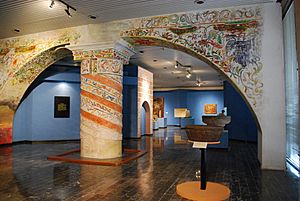Regional Museum of Anthropology and History of Chiapas facts for kids
The Regional Museum of Anthropology and History of Chiapas (also known as Museo Regional de Antropología e Historia de Chiapas) is a really important museum in Tuxtla Gutiérrez, Chiapas, Mexico. It's one of the biggest and best museums of its kind in the country!
This museum has two main parts. One part shows off the amazing ancient history of the region, focusing on the Mesoamerican cultures like the Zoque and Maya. The other part tells the story of Chiapas from when the Spanish arrived all the way up to the early 1900s. Besides these main exhibits, the museum also has a special hall for temporary shows and an auditorium for cool events like book signings, summer classes, and talks.
Contents
About the Museum Building
The Regional Museum of Anthropology and History is the largest museum in Tuxtla Gutiérrez. The building itself is quite modern, built between 1979 and 1982, and the museum first opened its doors in 1984. It's located right next to Madero Park.
The museum was designed by an architect named Juan Miramontes Nájera. His design was so good that it won a top award at an architecture contest in Sofia, Bulgaria, in 1985! Inside, you can see a special mural called “The Magical World of the Mayas.” This painting was originally made in 1963 by Leonora Carrington for another museum in Mexico City, but it was later moved to its permanent home here in Chiapas.
Exploring the Permanent Collections
The museum's main collection tells the story of Chiapas through time. It's split into two big halls: one for ancient history (archeology) and one for history starting from the Spanish arrival. Most of the signs are in Spanish, but many also have English translations, which is helpful!
Ancient History: Archeology Hall
The archeology hall takes you on a journey through Chiapas's pre-Hispanic past, before the Spanish came. It focuses on the Zoque and Maya cultures that lived here. The items are shown in three time periods:
- The Preclassic Period: This is the earliest time, from about 2000 to 300 BCE. It's when people started building farming villages. Powerful groups like the Olmecs were expanding, and important cities like Izapa and Chiapa de Corzo were growing.
- The Classic Period: From 300 BCE to 900 CE, this was the golden age of the Maya civilization. Some important Zoque settlements also thrived during this time.
- The Postclassic Period: This period starts around 900 CE, after the big Maya cities declined. People in this area spread out into smaller communities. Later, the Aztecs from central Mexico started moving into Chiapas, taking over some regions.
In this hall, you'll see ancient artifacts, along with diagrams, maps, and copies of old murals to help you understand the context of these amazing pieces.
Modern History: From Conquest to Revolution
The second hall covers the history of Chiapas from the Spanish conquest up to the early 1900s. This section is divided into different eras:
- The Spanish conquest of the area.
- The colonial period.
- The time of Independence.
- The Reform War era.
- The period of Porfirio Díaz (a former president).
- The Mexican Revolution.
Here, you can see old weapons, tools, historical papers, paintings, and Catholic religious items. Many of these come from places like Chiapa de Corzo, San Cristóbal de las Casas, and an old monastery in Tecpatán.
Events and Special Exhibitions
Besides the two main halls, the museum has another hall just for temporary exhibits and a large auditorium that can hold 250 people. These spaces are used for museum events and other cultural activities.
The museum offers lots of fun things to do, like summer courses, concerts, book signings, and special exhibitions. They even set up a traditional altar for Day of the Dead every year, which is a big attraction for both locals and tourists. The altar is created with the help of artists and craftspeople from Chiapas, showing off the state's unique traditions.
Summer classes often include workshops on archeology, making pottery, and different arts like watercolor painting, especially for children. The museum also has a Sunday movie club for kids.
The museum celebrates the annual International Museum Day with the International Council of Museums by hosting music, guided tours, talks, and other activities. Since 2001, the museum has also sponsored a Children’s Culture Day. This event focuses on primary school children from areas with lower incomes, bringing together different organizations to offer fun and educational activities. About 200 children attend each year!
Past Temporary Exhibits
The temporary exhibits at the museum are always changing and feature a wide range of topics, from ancient artifacts to modern art.
- One exhibit called “Soul of Clay” showed about 350 ceramic pieces, some of which were over 4,000 years old!
- Another exhibit, "Brujos y chamanes" (Male Witches and Shamans), featured thirty artworks by Chiapas artists. It explored the native magical traditions of the state and how they have influenced the culture.
- The museum also had a special exhibition called “The Pre Hispanic Jaguar, Footprints of the Divine.” This exhibit focused on ancient pieces related to the jaguar. In many Mesoamerican cultures, the jaguar was seen as a powerful, supernatural symbol, and its image appears in ancient art from very early times. People still respect this animal in many indigenous groups today. The exhibit included sculptures of human-jaguar figures, like "The Dancing Jaguar" and "The Corn Protector" from Izapa. It also showed many jaguar images on pottery and other tools from different parts of Chiapas.
16°45′35.42″N 93°6′24.22″W / 16.7598389°N 93.1067278°W
See also
 In Spanish: Museo Regional de Chiapas para niños
In Spanish: Museo Regional de Chiapas para niños




